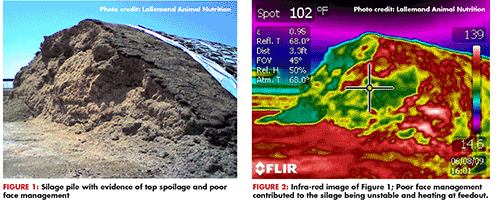
Maintain production by watching for unstable forages during warm weather

As the weather begins to warm up, it's a critical time to watch for instability in forages, which can threaten the quality of rations and negatively affect production.
"When aerobically unstable silage is blended into total mixed rations (TMRs), it can cause the entire ration to heat," says Anthony Hall, MSc MSB, PAS, Technical Services, Ruminant, with Lallemand Animal Nutrition. "This leads to nutrient and energy loss, plus it reduces palatability. When cattle eat less of the TMR - coupled with the fact that the ration they do eat is of lesser quality - it's a recipe for impaired rumen function, reduced energy intakes and declines in production."
Aerobic instability in silage is almost always caused by the growth of spoilage yeasts, which can cause increases in forage pH. In turn, this allows for further spoilage by molds and undesirable bacteria. At the site of spoilage, there are losses of digestible dry matter (DM) and increases in temperature.
"Feeding hot TMR to cattle when it's already warm outside only further decreases potential DM intake," Hall says. "When cattle do eat the TMR, the poorer quality of a hot ration can push a cow with border-line rumen function into Sub Acute Ruminal Acidosis, or SARA."
SARA is when the rumen environment spends three hours or more below a pH of 5.8 during a 24-hour period.3 Costs from SARA are estimated at $1.12 per cow per day, making it recognized as the most important nutritional issue of dairy cattle on a herd basis. When SARA occurs, rumen function isn't optimized to make the best use of any ration. Even in-feed buffers like sodium bicarbonate can't eliminate the risk of SARA.
To help reduce the risk of production losses, Hall recommends first preventing forage losses and heating by using a research-proven forage inoculant that can help combat aerobic instability. Inoculants using the high application-rate Lactobacillus buchneri 40788 can help ensure the forage base stays cool and stable in the bunk and minimize heating in the TMR. L. buchneri 40788 is the only bacterial inoculant reviewed by the FDA to prevent heating and spoilage - two factors that can greatly affect silage quality.
Adding a probiotic active dry yeast (ADY) - like Levucell® SC (Saccharomyces cerevisiae CNCM I-1077) - can improve rumen function and increase fiber digestion for all life stages of both beef and dairy cattle. In particular, Saccharomyces cerevisiae CNCM I-1077 can help minimize production losses during heat stress conditions7 and maintain rumen function if aerobically unstable forages have been fed to cattle.
"Reducing the risk of heat stress and SARA in your cattle can help preserve production and DM intake," Hall says. "Be on the lookout for hot, unstable silages and the profit-robbing effects of SARA. Ask your nutritionist or feed supplier what you can do to minimize production losses."
 Lallemand Animal Nutrition is committed to optimizing animal performance and well-being with specific natural microbial product and service solutions. Using sound science, proven results and knowledge, Lallemand Animal Nutrition develops, manufactures and markets high value yeast and bacteria products ? including probiotics, silage inoculants and yeast derivatives ? and offers a high level of expertise, leadership and industry commitment to move our partners Forward. Lallemand Animal Nutrition Specific for your success. For more information, please visit www.LallemandAnimalNutrition.com
Lallemand Animal Nutrition is committed to optimizing animal performance and well-being with specific natural microbial product and service solutions. Using sound science, proven results and knowledge, Lallemand Animal Nutrition develops, manufactures and markets high value yeast and bacteria products ? including probiotics, silage inoculants and yeast derivatives ? and offers a high level of expertise, leadership and industry commitment to move our partners Forward. Lallemand Animal Nutrition Specific for your success. For more information, please visit www.LallemandAnimalNutrition.com 6.12.2015